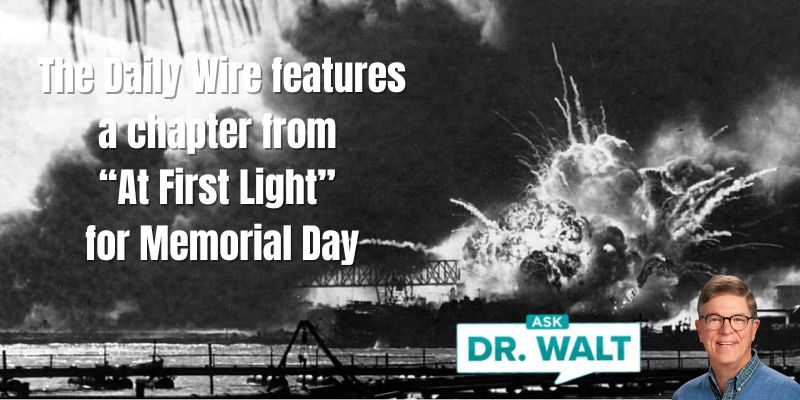
February 18, 1944 – A teenage WWII hero rides a master dressage stallion — Magellan
February 18, 2024
February 20, 1944 – A teenage WWII hero arrives at his new unit on Anzio
February 20, 2024On February 19, 1944, Phil received his orders to report to the 30th Infantry Regiment on the Anzio Beachhead. Late that afternoon, he hopped aboard a truck and was driven to the Naples harbor.

“Praise be to God for this captured sod, that rich with blood does seep;
With yours and mine, like butchered swine’s, and hell is six feet deep.
That death awaits, there’s no debate; no triumph will we reap.
The crosses grow on Anzio, where hell is six feet deep.”
—Audie Murphy, World War II Medal of Honor recipient who fought at Anzio
When he arrived, Phil saw a hundred or more LSTs[1] in the process of loading.
A fellow officer, Russell Cloer, wrote, “I vividly remember trudging up the ramp and seeing large white letters over the gaping entry maw, which read, ‘Gateway to Glory.’ A patriotic gesture? Or a swabbie’s gallows humor? It didn’t do much to raise my morale.”
Nor did the Italian boys swarming around the gangplank queues hawking an English-language newspaper with the headline, “Anzio Worse Than Salerno,” referring to the bloody Allied invasion of Italy on September 3, 1943.
The flotilla of LSTs sailed out of Naples Harbor as the sun set, with Phil aboard one of them in full combat gear. This was it—he was entering a war zone.
In an earlier briefing, he had been told that the trip up the coast to Anzio happened only at night because of German aircraft, E-boat, and U-boat threats. The distance was not far, around 120 miles, but the LSTs did not move very fast, leading some to call them “Large Slow Targets.”
Phil was grateful that it was a very dark night as the convoy of LSTs made their way up the coast, staying only a couple of miles offshore. As they approached Anzio, the men could clearly see the shell bursts and machine gun ricochets, as well as an occasional flare, from the inland battle lines. Not a single man could sleep.
At first light on February 20, Phil’s LST was about 3,000 yards offshore from Anzio. In the sky above the besieged beachhead, Phil and his companions, who were crowding the deck, gazed at over two dozen sixty-foot long, hydrogen-filled barrage balloons floating in the sky. Also called blimps, they were tethered with metal cables that could be winched up or down to vary their height over the harbor. Their purpose was ingenious: to deny low-level airspace to Luftwaffe dive-bombers, as well as strafing fire from enemy fighters.
Out of the corner of his eye, Phil saw a massive projectile moving faster than a dive-bomber coming in their direction. The shell—which looked larger than a refrigerator—came from a Krupp K5 railway gun,[2] capable of sending 543-pound shells nearly forty miles. As the shrill whistle of the projectile grew louder, the men instinctively ducked. But Phil kept his eyes just above the gunwale and saw the gigantic projectile slam into an LST next to theirs, which instantly exploded into a mushroom cloud of flames and smoke. He ducked as water and debris rained down on their deck.
It was an awful moment, and if there was any consolation, it was that this particular LST was carrying only ammunition and supplies and no men other than her doomed crew. Because of the desperate need for ammo on the beachhead, some LSTs sailing from Naples carried a hundred tons of ammunition, triple the prudent load.
Then the signal came. Phil’s LST lurched forward, rapidly coming to full speed, and made its run for the beach. He was fully aware that the LST’s clear mission was to get in, unload, and back out as quickly as possible.
When his LST hit the beach, the clamshell doors flew open, the ramp quickly dropped, and fifty fully supplied 6×6 trucks unloaded in less than four minutes. The 6x6s raced down the ramp and headed toward their predetermined destinations—widely scattered supply dumps one or two miles inland. Between the trucks, Phil and the other soldiers dashed down the ramp.
As the last vehicle was gunning down the ramp, the LST signaled, and a stream of 6x6s carrying hundreds of casualties—the toll of the previous day’s battle—lined up to board for the return trip. Phil got a glimpse of wounded men on litters clutching their X-rays in big brown envelopes. Those in casts wore medical descriptions of their injuries scribbled on the plaster. As soon as the injured aboard the trucks were loaded, the ramp went up, the clamshell doors slammed shut, and the LST headed back out to sea.
Phil and his fellow replacements moved forward at a trot in two columns. When they had gone about half a mile, they came to a large open field, where they stood in line to receive their assignments. When Phil got to the front, a seasoned officer handed him a paper notifying him of his assignment: Platoon Leader, Ammunition Pioneer Platoon,[3]Headquarters Company, 3rd Battalion, 30th Infantry Regiment, 3rd Infantry Division, VI Corps. The officer commented, “Welcome to the Rock of the Marne,[4] son. You’re a Dogface Soldier[5] now.”
Here’s some additional information from my research that did not make it into the book:
Wide-eyed they lined the rails as the ships slid into Anzio Harbor—now known as Bomb Bay—actually unconvinced by a memo from higher authority that declared, “The chances of being hit by a shell from a shore battery are negligible, being approximately 37,000 to 1 for every shell actually falling in the anchorage.”
Stevedores moved with feline agility, unloading the 50 vehicles from an LST in four minutes or stacking three tons of cargo into a DUKW in six minutes, all the while straining for the whistle of artillery are the glint of an enemy playing.
In twelve weeks the port and anchorage had sustained 277 Luftwaffe raids, one every seven hours. Radio-controlled Fritz X bombs had been largely neutralized buy electronic jammers on destroyers and minesweepers, but torpedoes, aerial mines, machine-gun strafings, and conventional bombs—plus shells by the tens of thousands—continued to batter both roadhead and beachhead.
The toll could be seen in the hundred or so casualties waiting dockside each day for the return convoy to Naples: wounded men on litters clutched their own X-rays in big brown envelopes, and those in casts wore medical descriptions of their injuries scribbled on the plaster. When German rounds began to fall, patients lashed to stretchers sometimes out screamed the screaming shells.
One commander greeted a new consignment of troops by telling them, “Your going to suffer. You came here to suffer.”
A British officer arriving in March described Anzio as “a small town rapidly getting smaller.”
Beyond the barrage balloons along the seawall “there was hardly a building and tax. Lonely walls leaned drunkenly against piles of rubble; roofs seem to have gone out of fashion: and wires dangled everywhere.”
The captain of H.M.S. Grenville concurred, writing that “the whole waterfront had a very moth eaten and look about it.”
Each day new arrivals stepped onto the harbor jetty, where MPs barked, “Get moving, get moving!” They scurried past waterfront villas gnawed by shell fire—the masonry peeling “like sunburned skin,” as the writer John Lardner put it—out to the “small, wet world” now known to its denizens as the Bitchhead. “You could see a squirt of white tracer and it seemtd to float toward our lines. That was Jerry. Ours answered with bursts that had red tracer in them.”
“A 3rd Division soldier recalled, “Tommies veered to the left … Yanks veered to the right, to a warren of trenches and hovels where young men wheezed like rheumy old men, scraping the muck from their uniforms with trench knives.
Upon making shore with reinforcements for the 1st Armored Division, tank commander Henry E. Gardiner told his diary, “Our first sight as we drove to inland was a shockingly large United States cemetery.”
Since Sicily, the turnover of lieutenants had exceeded 100 percent. Truscott knew that esprit would be vital in the coming weeks. So, too, would robust health, and for the past month medicos had struggled to bring the division to fighting trim by treating ailments from trench foot to bronchitis to gonorrhea. To soothe his own chronically inflamed vocal cords, Truscott had scheduled three paintings of his throat with silver nitrate during the 120-mile voyage to Anzio.
In his diary, [General Mark Clark] noted that as of this day (?Tuesday, February 22) Fifth Army has sustained 72,982 casualties since landing at Salerno, a man down every three minutes for more than six months.
Anyone who was on the beachhead (in February and early March, 1944) had a pretty fair idea of the fate that awaited if the beachhead line had not held. The better part of thirteen German divisions sat in a watchful ring about that little patch of ground and did their best to make it the sort of Inferno such as a native son of Italy had once described as awaiting the souls of those who sinned on earth. Danté’s descriptions, however, were imaginary. Anzio, unfortunately, was not.
[1] An LST, or Landing Ship, Tank, was a ship developed during World War II to support amphibious operations by carrying tanks, vehicles, cargo, and landing troops directly onto shore with no docks or piers. Its highly specialized design allowed ocean crossings as well as shore groundings. The bow had a large door that could open, deploy a ramp, and unload vehicles due to a special flat keel that allowed the ship to be beached and stay upright.
[2] The Krupp K5 was a heavy railway gun used by Nazi Germany throughout World War II. These 280-mm railroad guns were known by the Americans as “Anzio Annie,” “Anzio Express,” or “Whistling Pete” due to the express train-like sound the shells generated. The railway gun had a 71-foot long, 11-inch bore barrel that fired shells weighing nearly 600 pounds. The shells traveled as far as 38 miles, and even duds could crater fifty feet into the earth.
[3] An Ammunition & Pioneer Platoon, or A&P Platoon, was typically one junior officer (a 2nd lieutenant), a sergeant to assist him, and a driver for the platoon vehicle, which mounted a .50-caliber heavy machine gun. Each of its three eight-man squads was led by a sergeant. The platoon was also equipped with two bazookas for antitank defense. They carried ammunition to the riflemen, set and cleared mines and booby traps, rolled out concertina wire, and did small engineering projects such as marking, building, or repairing paths or trails.
[4] “Rock of the Marne” was a nickname the 3rd Infantry Division earned in World War I when the division was outnumbered and fought with primarily inexperienced young men against hardened veterans. Their heroic actions proved to be a turning point during the last German offensive as they stopped three German divisions from crossing the Marne River.
[5] “Dogface” generally refers to a U.S. Army foot soldier serving in the Infantry, especially in World War II. The term was adopted from a song, “The Dogface Soldier,” written in 1942 by two GIs and widely played and sung during the war.
In case you haven’t read or listened to Dad’s book, you can learn more or order it here.
© Copyright WLL, INC. 2024.




